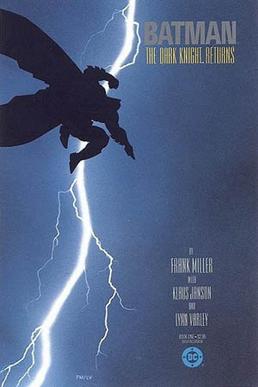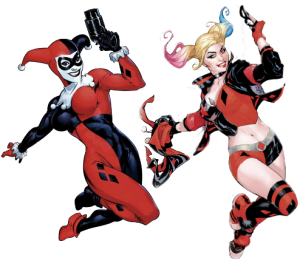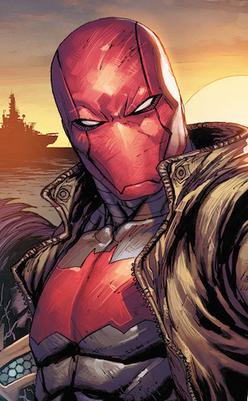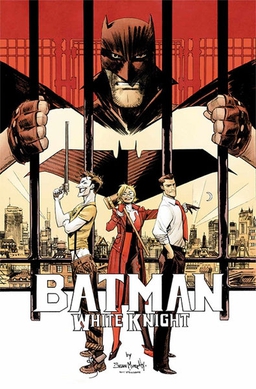
The Dark Knight Returns is a 1986 four-issue comic book miniseries starring Batman, written by Frank Miller, illustrated by Miller and Klaus Janson, with color by Lynn Varley, and published by DC Comics. It tells an alternative story of Bruce Wayne, who at 55 years old returns from retirement to fight crime and faces opposition from the Gotham City police force and the United States government. The story also features the return of classic foes Two-Face and the Joker, and culminates with a confrontation with Superman, who is now a pawn of the government.

The Joker is a supervillain appearing in American comic books published by DC Comics. The character was created by Bill Finger, Bob Kane, and Jerry Robinson, and first appeared in the debut issue of the comic book Batman on April 25, 1940. Credit for the Joker's creation is disputed; Kane and Robinson claimed responsibility for the Joker's design while acknowledging Finger's writing contribution. Although the Joker was planned to be killed off during his initial appearance, he was spared by editorial intervention, allowing the character to endure as the archenemy of the superhero Batman.

Batman is an American live-action television series based on the DC Comics character of the same name. It stars Adam West as Bruce Wayne/Batman and Burt Ward as Dick Grayson/Robin—two crime-fighting heroes who defend Gotham City from a variety of archvillains. It is known for its camp style, upbeat theme music, and its intentionally humorous, simplistic morality. This included championing the importance of using seat belts, doing homework, eating vegetables, and drinking milk. It was described by executive producer William Dozier as the only situation comedy on the air without a laugh track. The 120 episodes aired on the ABC network for three seasons from January 12, 1966, to March 14, 1968, twice weekly during the first two seasons, and weekly for the third. In 2016, television critics Alan Sepinwall and Matt Zoller Seitz ranked Batman as the 82nd greatest American television series of all time. A companion feature film was released in 1966 between the first and second seasons of the TV show.

Harley Quinn is a fictional character appearing in American comic books published by DC Comics. Quinn was created by Paul Dini and Bruce Timm as a henchwoman for the supervillain Joker in Batman: The Animated Series, and debuted in its 22nd episode, "Joker's Favor", on September 11, 1992. While intended to appear in one episode, Quinn became a recurring character within the DC Animated Universe as the Joker's sidekick and love interest, and was adapted into DC Comics' Batman comic book canon seven years later, beginning with the one-shot Batman: Harley Quinn #1. Quinn's origin story features her as a former psychiatrist at Gotham City's Arkham Asylum named Dr. Harleen Quinzel who has fallen in love with the Joker, her patient, eventually becoming his accomplice and lover. The character's alias is a play on the stock character Harlequin from the 16th-century Italian theater commedia dell'arte.

The Batmobile is the fictional car driven by the superhero Batman. Housed in the Batcave, which it accesses through a hidden entrance, the Batmobile is both a heavily armored tactical assault vehicle and a personalized custom-built pursuit and capture vehicle that is used by Batman in his fight against crime. Using the latest civilian performance technology, coupled with prototype military-grade hardware—most of which was developed by Wayne Enterprises—Batman creates an imposing hybrid monster car to prowl the streets of Gotham City.

The Batman is an American animated television series based on the DC Comics superhero Batman. Developed by Michael Goguen and Duane Capizzi, and produced by Warner Bros. Animation, the series first aired on Kids' WB on September 11, 2004, then Cartoon Network on April 2, 2005. The show would become exclusive to the former network for its third, fourth, and fifth seasons in early 2006. The Batman won six Daytime Emmy Awards over the course of its run. Many elements from previous Batman storylines were borrowed and adapted, such as those from the comic books, film series and the animated shows like Batman: The Animated Series from the DC Animated Universe, but it remained strictly within its own distinct continuity. Jackie Chan Adventures artist Jeff Matsuda served as art director and provided the character designs. The production team altered the appearances of many of the comic books' supervillains for the show, such as the Joker, the Penguin, and the Riddler.

Bat-Mite is a fictional character appearing in American comic books published by DC Comics. Bat-Mite is an imp similar to the Superman villain Mister Mxyzptlk. Depicted as a small, childlike man in an ill-fitting Batman costume, Bat-Mite possesses what appear to be near-infinite magical powers, but he actually uses highly advanced technology from the fifth dimension that cannot be understood by humans' limited three-dimensional views. Unlike Mxyzptlk, Bat-Mite idolizes his superhero target and thus he has visited Batman on various occasions, often setting up strange and ridiculous events so that he could see his hero in action. Bat-Mite is more of a nuisance than a supervillain, and often departs of his own accord upon realizing that he has angered his idol.

Firefly is a supervillain appearing in American comic books published by DC Comics. Created by France Herron and Dick Sprang, he made his debut in Detective Comics #184. Initially portrayed as a criminal who utilized lighting effects to commit robberies, Firefly was later reimagined as a sociopathic pyromaniac with an obsessive compulsion to start fires following Crisis on Infinite Earths' reboot of the DC Universe in the 1980s. This darker depiction of the character has since endured as one of the superhero Batman's most recurring enemies and belongs to the collective of adversaries that make up his central rogues gallery.

The Red Hood is an alias used by multiple characters appearing in American comic books published by DC Comics. The identity was first used in the 1951 storyline "The Man Behind the Red Hood!", which provides the earliest origin story for the Joker. The storyline depicts an unnamed criminal wearing a red dome-shaped hood who, after a chance encounter with Batman, is disfigured by chemicals and becomes insane, giving birth to his future Joker persona.

Lego Batman was a theme and product range of the Lego construction toy, introduced in 2006, based on the superhero character Batman, under license from DC Comics. The sets feature vehicles, characters and scenes from the comics and films. The inspirations for the design of these vary widely. For example, the Batmobile retains its basic sleek shape and prominent fins from the Tim Burton films, whereas the "Bat-Tank" seems to be based on the tank-like Batmobile in Frank Miller's The Dark Knight Returns. The theme was relaunched in early 2012 as part of the Lego DC Universe Superheroes line, which is a sub-theme of the Lego Super Heroes line. In total there were 17 sets, almost all of them including Batman.

The Batplane, Batwing, Batjet or Batgyro is the fictional aircraft for the DC Comics superhero Batman. The vehicle was introduced in "Batman Versus The Vampire, I", published in Detective Comics #31 in 1939, a story which saw Batman travel to continental Europe. In this issue it was referred to as the "Batgyro", and according to Les Daniels was "apparently inspired by Igor Sikorsky's first successful helicopter flight" of the same year. Initially based upon either an autogyro or helicopter, with a rotor, the Batgyro featured a bat motif at the front. The writers gave the Batgyro the ability to be "parked" in the air by Batman, hovering in such a way as to maintain its position and allow Batman to return.
Zebra-Man is the name of four fictional characters appearing in American comic books published by DC Comics.

Lego Batman 2: DC Super Heroes is a 2012 Lego-themed action-adventure game developed by Traveller's Tales and published by Warner Bros. Interactive Entertainment. The game is a sequel to Lego Batman: The Videogame and the second installment in the Lego Batman series. The game's main storyline follows Batman, Robin and later Superman as they attempt to foil the Joker and Lex Luthor's plans to have the latter become president of the United States, joining forces with the Justice League along the way. As a result, the game's cast is larger than its predecessor and includes characters outside of the Batman series.

Batman: White Knight is an American comic book published by DC Comics. The eight-issue limited series, written and illustrated by Sean Murphy, began monthly publication in October 2017 and concluded in May 2018. In the series, the Joker is seemingly cured of his madness and sets out to become a politician under his real name of Jack Napier, seeking to change his public image as a "villain" and save Gotham City from Batman, whom he views as the real enemy of the city.

Batman: Curse of the White Knight is an American comic book published by DC Comics under its Black Label imprint. The eight-issue limited series, written and illustrated by Sean Murphy, began publication on July 24, 2019 and concluded on March 25, 2020. It is the sequel to Batman: White Knight and is the second installment in the Murphyverse's White Knight series, which takes place within a self-contained alternate reality that is different from and unrelated to the main DC Universe.
The Mutants is the name of a fictional street gang appearing in American comic books published by DC Comics. While the Mutants were first seen in The Dark Knight Returns, there were other incarnations of the Mutants that appeared in later Batman comics.

The Scarecrow, a supervillain in DC Comics and an adversary of the superhero Batman, has been adapted in various forms of media, including films, television series and video games.

Batwheels is an American computer-animated superhero children's television series that premiered on September 17, 2022, on HBO Max, and on October 17, 2022, on Cartoon Network's preschool block, Cartoonito.

Batman: Beyond the White Knight is an American comic book published by DC Comics under its Black Label imprint. The eight-issue limited series — written and illustrated by Sean Murphy, lettered by AndWorld Design and colored by Dave Stewart — began its monthly publication on March 29, 2022 and ended on February 14, 2023. It is the sequel to both Batman: White Knight (2017–18) and Batman: Curse of the White Knight (2019–20), and is also the fifth installment in Murphy's self-titled Murphyverse line. It is also an adaptation of the animated television series Batman Beyond (1999–2001), with the plot of the comic book being based on the original premise of the TV show.
















